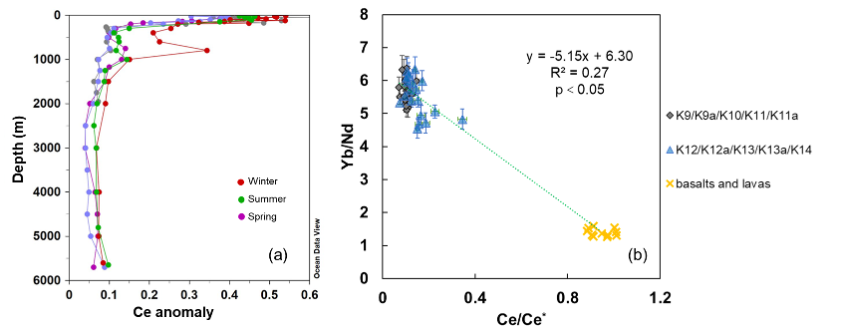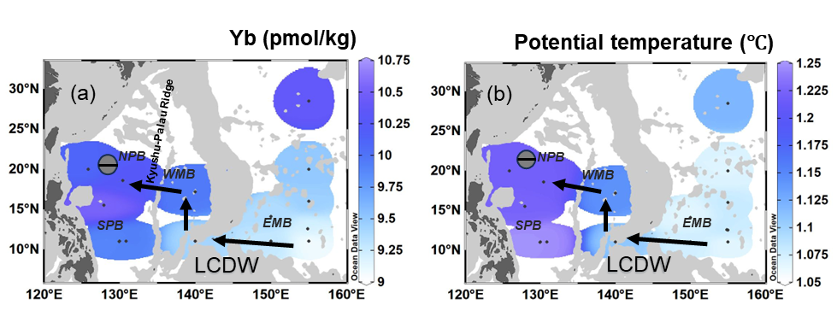Comprehensive quantification of the rare earth element cycle in the northwest Pacific Ocean
Cao and co-authors (2024, 2025, see references below) present a comprehensive investigation of dissolved rare earth elements (REEs) and their controlling factors in the northwest Pacific, using 919 REE datasets from 62 stations across three GEOTRACES-CHINA cruises (GP09, GPpr15-winter, and GPpr15-summer) aboard the R/V TAN KAH KEE. Their research focuses on the spatiotemporal variability and cycling of REEs in the North Pacific Subtropical Gyre (NPSG), with a particular emphasis on biogeochemical processes and lithogenic inputs. They also demonstrate the potential of heavy REEs as tracers for water mass mixing at the basin scale in the northwest Pacific. The key findings are as follows:
- Above the depth of chlorophyll maxima, REE concentrations were lower in winter compared to summer, reflecting enhanced scavenging by particulate matter driven by seasonally varying biogeochemical processes. In subsurface to intermediate waters (150–1000 m), the release efficiency of REEs during remineralization showed no seasonal variation and remained consistent between the NPSG and the North Atlantic Gyre (~0.04 pmol Nd/μmol apparent oxygen utilization). This ratio holds potential for applications in tracing external sources, characterizing plankton community structures, and estimating remineralization rates of organic carbon.
- Inputs of slope sediments to intermediate waters (500–1000 m) off the Philippine Islands were identified using Cerium (Ce) anomalies and ytterbium/ neodymium (Yb/Nd) ratios (Figure 1). The contribution of Nd is most significant during winter, accounting for 26 % ± 11 % of the observed Nd, with contributions of 18 % ± 9 % in summer and 11 % ± 5 % in spring.
- Yb effectively distinguishes intermediate water masses in the Northwest Pacific and reliably traces the Lower Circumpolar Deep Water (LCDW) distribution below 4000 m (Figure 2), with water masses controlling over 90% of its concentration. This underscores the utility of heavy REEs as tracers for water mixing in intermediate and deep water in the northwest Pacific.


References:
Cao, A., Liu, Q., Zhang, J., Liu, Z., Ren, J., Cai, Y., Zhou, K., Guo, X., & Liu, X. (2025). Spatiotemporal variation of dissolved rare earth elements in the North Pacific Subtropical Gyre: Influence of biogeochemical cycling and application in tracing deep water. Global and Planetary Change, 246, 104719. doi:10.1016/j.gloplacha.2025.104719
Cao, A., Liu, Q., Zhang, J., Shiller, A. M., Cai, Y., Zhang, R., Gilbert, M., Guo, X., & Liu, Z. (2024). Dissolved rare earth elements in the North Pacific Subtropical Gyre: Lithogenic sources and water mass mixing control. Geochimica et Cosmochimica Acta, 372, 42–61. doi:10.1016/j.gca.2024.02.018
Castillo, P.R., Newhall, C. G. (2004). Geochemical Constraints on Possible Subduction Components in Lavas of Mayon and Taal Volcanoes, Southern Luzon, Philippines. Journal of Petrology, 45, 1089–1108. doi: 10.1093/petrology/egh005
